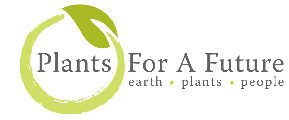Welcome to the digital download page of Plants For A Future. The books are digital copies of our paperback books. The downloads are in PDF format.
You can pay via PayPal or use a credit card from the PayPal screen. For hard-copy paperback books, please visit the main website at pfaf.org
PFAF have eight books available for download, all shown below
Digital books are now USD $9.99 (approximately GBP 6.50 and €8 Euros)
Food Forest Plants for Hotter Conditions $9.99 Digital Book
250+ Perennial Plants For Tropical and Sub-Tropical Food Forests and Permaculture Gardens
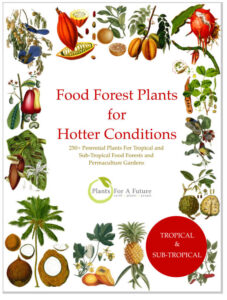
A tropical and sub-tropical food forest is a cornucopia of luscious food, which thrives on drawing carbon out of the atmosphere to grow trees, shrubs, herbaceous plants and climbers producing fruits, seeds, oils, greens, flowers, drinks and herbs. Thousands of known food plants thrive in hot climate zones; plants were discovered and improved from time immemorial, from before the Agricultural Revolution, which brought about deforestation and land degradation to provide grains to feed city-states. Our human ancestors were gatherers and gardeners; we may well have evolved with large brains to store and share knowledge of where nutritious plants were to be found and how to modify nature to encourage them.
FOOD FOREST PLANTS $9.99 Digital Book
PLANTS FOR YOUR FOOD FOREST: 500 PLANTS FOR TEMPERATE FOOD FORESTS AND PERMACULTURE GARDENS
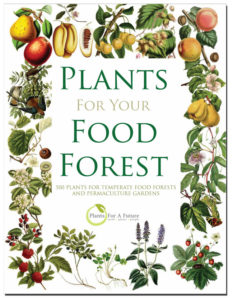
We have selected over 500 plants that provide a mix of different growing conditions, plant size and structure, type of food, and contribution to a food forest ecosystem. There is also a quick-reference table of the key characteristics. The featured plants are arranged in sections corresponding to Forest Layer: Shrubs, Groundcover Shrubs, Trees, Herbaceous Plants, Herbaceous Groundcover Plants, Running Bamboos, Bulbs, and Climbers. Further details of all the plants described here are available from the PFAF Plants Database, which can be accessed free of charge at pfaf.org
Edible Shrubs $9.99 Digital Book
70+ Top SHRUBS from plants for a future
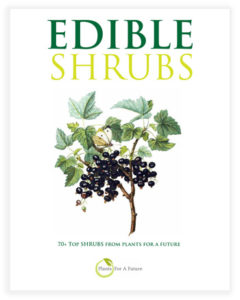
The digital book is $9.99 USD (approximately £6.50 GBP and €8 Euros) [PDF only]
Increasing interest in food forests or woodland gardens reflects a growing awareness that permanent mixed plantings are inherently more sustainable than annual monocultures. They can safeguard and enrich soil ecosystems, enable plants to form mutually beneficial combinations, utilise layers in the soil and above ground, and create benign microclimates that soften winds and recycle rain. Shrubs are important in food forests, occupying the highly productive layer between the canopy and the ground. Also, as perennial woody plants, shrubs help to draw down and store carbon from the atmosphere, a vital function to help combat damaging climate change.
Edible Shrubs provides detailed information, attractively presented, on over 70 shrub species. They have been selected to combine different plant sizes and growing conditions. Most provide delicious and nutritious fruit, but many also have edible leaves, seeds, flowers, stems or roots, or they yield edible or useful oil. The information here is based on practical experience and observation and from various reputable sources. For each entry, the descriptive text is augmented by summary information panels covering various attributes such as natural habitat, preferred soils, nutritional value, and potential uses within woodland garden designs.
We have included some more unusual species that may not be known to growers interested in a wider variety of food crops or in more resilient plot designs. This book also includes a quick reference table of the key characteristics of over 400 other perennials to help readers identify plants that meet specific requirements. Further details of all the plants described here are available from the PFAF Plants Database, which can be accessed free of charge at pfaf.org.
Edible Perennials $9.99 Digital Book
50 Top perennials from plants for a future
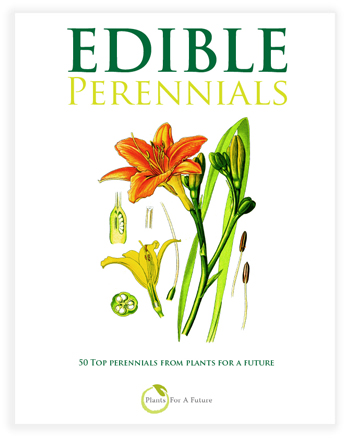
The digital book is $9.99 USD (approximately £6.50 GBP and €8 Euros) [PDF only]
Current interest in forest or woodland garden designs reflects an awareness that permanent mixed plantings are inherently more sustainable than annual monocultures. They safeguard and enrich soil ecosystems, enable plants to form cooperative combinations, make use of layers above and below the soil, and they create benign microclimates which soften winds and recycle the rain. The challenge is productivity: how can yields of useful foods and other useful materials be maximised? The latest book from Plants For A Future is a resource for discovering some of the answers.
Edible Perennials provides detailed information, attractively presented, on 50 selected perennial plants, based on practical experience and observation, plus a wide range of reputable sources. All these plants yield edible produce: roots, tubers, seeds, oils, fruits, stems, flowers, or leaves, and many have other useful properties, which are also described. For each entry the descriptive text is augmented by summary information panels covering various attributes such as natural habitat, cultivation needs, nutritional value of edible parts, and potential uses within woodland garden designs.
We have included some more unusual species that may not be well known to growers interested in trying out different food crops and new designs for their plots. The book also has a reference table of the key characteristics of nearly 400 other perennials, to help readers to identify plants that meet their particular requirements.
Edible Plants: French Translation $9.99
Plantes Comestibles: Le guide pour vous inspirer a choisir et cultiver des plantes comestibles hors du commun
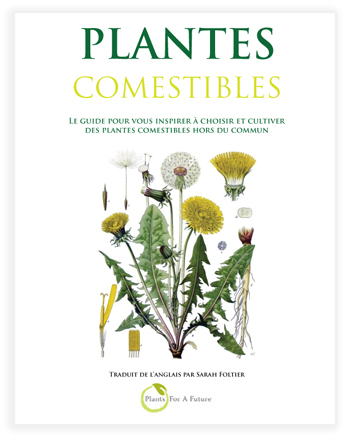
The digital book is $9.99 USD (approximately £6.50 GBP and €8 Euros) [PDF only]
Il existe plus de 20 000 espèces de plantes comestibles dans le monde et pourtant, 90% de notre régime alimentaire ne se compose que d’une vingtaine. Pourtant, des centaines de plantes comestibles moins connues, venant du monde entier sont à la fois délicieuses et très nutritives.
Nous sommes convaincus que les plantes peuvent répondre à la majorité de nos besoins, tout en respectant la santé de notre planète. Un large éventail de plantes peuvent être cultivées pour satisfaire tous nos besoins alimentaires et bien d’autres encore, tout en offrant une grande
diversité d’habitats pour la faune et la flore.
Cet ouvrage vous fera découvrir comment cultiver et utiliser quelques-unes de ces plantes moins connues, en particulier les plantes vivaces.
French Translation of our book Edible Plants
Woodland Gardening $9.99 Digital Book
Woodland Gardening: Designing a low-maintenance, sustainable edible woodland garden with fruit and nut trees, shrubs, herbs, vines and perennial vegetables
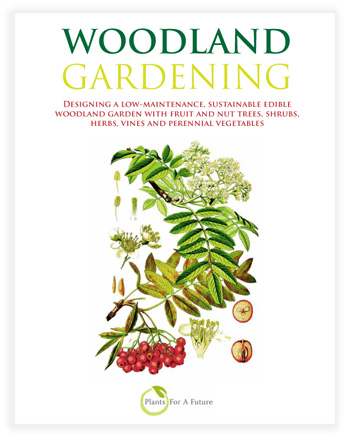
The digital book is $9.99 USD (approximately £6.50 GBP and €8 Euros)
[PDF and Mobi/Kindle]In a woodland garden, everything grows together in a way that is very similar to a natural woodland but with the trees and shrubs all bearing edible crops, and with many different edible herbs and vegetables growing under them. Instead of battling against nature, this is a garden that works in harmony with it.
It is possible to plan out a woodland garden in a space as small as a backyard or as large as a few acres, using the guidelines that nature has shown us, but using species that can provide us with fruits, seeds, leaves, roots and flowers that are delicious and highly nutritious. When well designed, such a system can:
- be far more productive than a field of annuals
- produce a much wider range of foods
- require far less work
- require far fewer inputs such as fertilizers and pesticides
- provide valuable habitats for wildlife
- be very pleasing aesthetically.
It all comes down to selecting the right mixture of species. There are over 5,000 species of edible plants that can be grown outdoors in temperate climates and about 2,100 of these can be grown in a woodland so there really is no lack of variety to choose from.
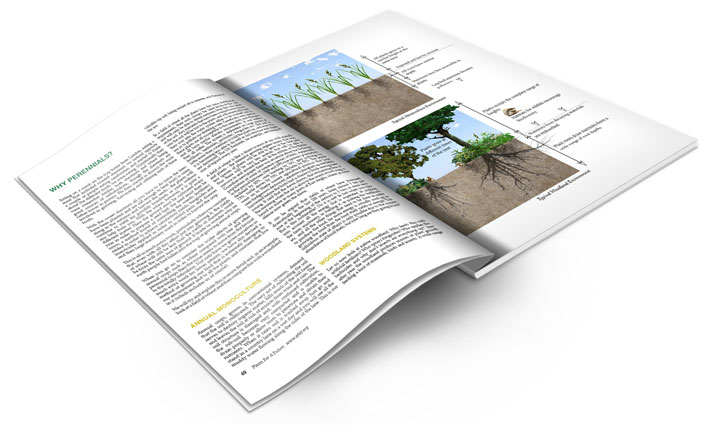
Edible Plants $9.99 Digital Book
An inspirational guide to choosing and growing unusual edible plants
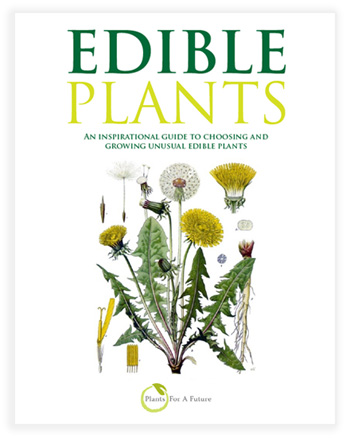
The digital book is $9.99 USD (approximately £6.50 GBP and €8 Euros) [PDF and Mobi/Kindle]
There are over 20,000 species of edible plants worldwide,, yet fewer than 20 species now make up 90% of our food. However, hundreds of lesser-known edible plants from all over the world are delicious and nutritious.
We believe that plants can provide people with the majority of their needs in a way that cares for the planet’s health. A wide range of plants can be grown to produce all our food needs and many other commodities whilst also providing diverse habitats for our native flora and fauna.
This book describes and provides advice on growing some lesser-known and unusual edible plants, emphasising perennials. Information includes Alternative Fruits and Root Crops, Edible Leaves, Edible Flowers, Winter Salads, Staple Seed Crops and Useful Weeds.
Edible Trees $9.99 Digital Book
A practical and inspirational guide from Plants For A Future on how to grow and harvest trees with edible and other useful products.
The digital book is $9.99 USD (approximately £6.50 GBP and €8 Euros) [PDF and Mobi/Kindle]
When we think of edible trees we tend to focus on a few common varieties that give us fruit. However, many excellent, less well-known trees can produce edible flowers, oil, seeds, nuts, leaves, sap and bark, and fruit. Many also have important medicinal applications. We also identify other uses of products derived from these trees, including fibres for clothes, rope and paper, oils for lubricants, fuels, waterproofing and wood preservatives, dyes, construction materials, and more. This book describes 50 of our favourite edible trees, each illustrated and arranged alphabetically by common name. Complementing the images is a physical description of each species and information on their origin, growth habit, preferred hardiness zone, edible and medicinal ratings, known hazards, weed potential, propagation, care and cultivation.
This book describes and provides advice on growing Plants For A Future’s favourite edible trees.
Temperate Plant Database
Currently, the database is available in three forms for 7400 temperate plants.
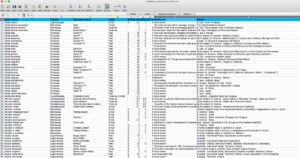
1. A Microsoft Excel file
2. A CSV file for other spreadsheets
3. A DB FIle. You can also export any of the tables as CSV. Use a DB Browser, for example, the DB Browser for SQLite is a high-quality, visual, open-source tool to create, design, and edit database files compatible with SQLite. http://sqlitebrowser.org/
